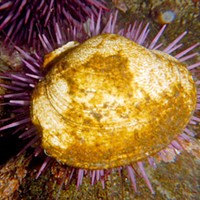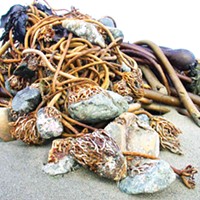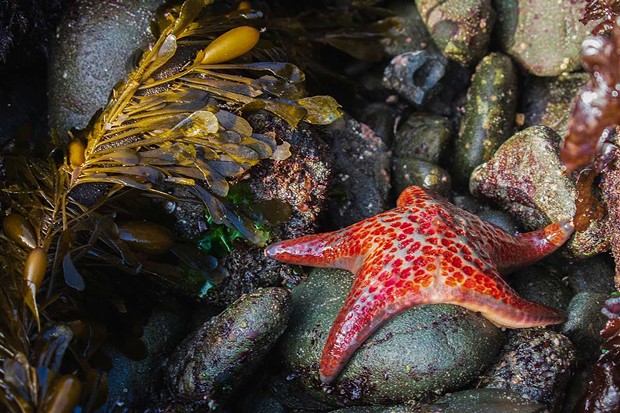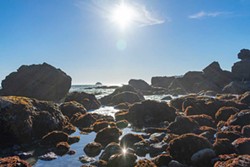[
{
"name": "Top Stories Video Pair",
"insertPoint": "7",
"component": "17087298",
"parentWrapperClass": "fdn-ads-inline-content-block",
"requiredCountToDisplay": "1"
}
]
Humboldt County beaches cannot just be visited, they must be experienced. And getting up close with marine life in tide pools should be at the top of this summer's to-do list. Here are some tips on doing it right.
Whether it's Indian Beach, Palmer's Point or Luffenholtz, we've got prime tide pools to explore. Attention newcomers: Before you hop in the car with a blanket or towel and tan-ready clothes, stop and reconsider. This is a different kind of beach experience and if it's your first time, you'll want to go prepared.
Plan ahead
Tide pooling requires you to get a little wet and a little dirty. When the intertidal zone is exposed, so are slimy rocks and pools. Wear rain boots and old jeans or pants you're not super fond of. Same goes for a shirt or jacket — pick something comfortable and fit for wet, rocky areas.
Once you're dressed, look up the tides on a site like www.willyweather.com for your beach of choice. The best time to visit tide pools is when the chart shows a very low or negative number. Negative numbers, indicating heights that fall below the average low water mark, are better for tide pooling.
Low tide times can vary so make sure you pick a time that works for you — low tide at 6:30 a.m. isn't going to fit your plans for an afternoon visit.
Tide pool etiquette
One of the most important things a beginning tide pooler should remember is that these pools are actually tiny homes.
Scripps Institution of Oceanography research associate Macey Rafter said it's important to realize these animals and organisms do not want to be disturbed. She said when it comes to experiencing a tide pool, it's better to "take pictures, not the animals." In other words: Look, don't touch.
As tempting as it might be to pick up the nearest starfish or hermit crab, avoid touching the tide pool animals. Avoid overturning rocks to expose crabs and other animals, too.
As fascinating or cool as these animals or organisms may look, you're a visitor. When they are touched or moved, it creates stress. And again, watch your step. A loose rock can be a hazard to you but a home to creatures. Be cautious to avoid being hurt or hurting the tide pool ecosystem.
Don't forget to clean up after yourself. If you need to dispose of any trash or waste, make sure you take it with you. If you wouldn't litter at your home, don't litter in theirs.
What you'll find
Though water temperature and location will affect what kind of creatures and organisms you'll find, most tide pools will house similar species.
The most common are different types of starfish, sea anemones and crabs. While I was exploring, I came across striped shore crabs and a ton of hermit crabs. Though the hermit crabs are everywhere, finding the other crabs can be tricky. They scatter at the sight and sound of you. But if you're observant and examine a pool long enough or catch a glimpse between some rocks, you'll find some well-camouflaged eyes peeking out at you.
When exploring, be especially alert for the starfish in the area. Not all of them are bright like the dermasteria, or leather star. Some are cleverly colored ochre starfish or purple starfish. They blend in remarkably well with the rocks and are easy to miss. Some purple starfish are actually orange, so look out for those, too.
With some patience you'll catch a glimpse of most of these creatures without overturning rocks.
Favorite beaches
With the help of a friend and Arcata resident Isaac Winans, I visited three beaches roughly 15 to 20 minutes north of Arcata by car. After some thorough tide pooling, I ranked the beaches based on which had more creatures for tide pool beginners to see.
First place goes to Old Home (or Indian) Beach. Right next to Trinidad State Beach, this beach provided the most complete experience with its variety of pools and creatures. To get there, head into the town of Trinidad and get down to the water using the steps at Edwards and Trinity streets. Once you're there, head south down the beach toward the rocks.
Up next was Palmer's Point. Palmer's Point is in Patrick's Point State Park and the farthest away of the three. The pools were plentiful (though I discovered more in Indian Beach) and there's more to explore once you've had enough of the water here. This beach is about 10 minutes north of the town of Trinidad on U.S. Highway 101 and requires a fee for exploring the park. Bring $8 cash. Drive to the end of Palmer's Point Road to park and take the stairs down.
Third place goes to Luffenholtz Beach (1639 Trinidad Scenic Drive, Trinidad). Though beautiful as ever, these pools were a bit empty. However, along the road to Luffenholtz there are plenty of places to stop and climb down, and you may have better luck at another spot. This one may deserve a second visit. To get here, get off U.S. Highway 101 North at Westhaven Drive and take a left like you're going to the Moonstone Grill. At the split, take a right and be careful down the narrow road. Eventually you'll see several places to park. Pick one and carefully find your way down — it's steep.
Alternatives
The best part of tide pooling can be interacting and identifying the animals in the water. For explorers who want to touch, visit the Humboldt State University Telonicher Marine Laboratory (570 Ewing St., Trinidad). It has tide pools with creatures you can touch.
Speaking of...
-

NCJ Preview: Gift Guide, Karuk Land Return, Mushrooms and Crab
Nov 27, 2021 -

Purple Urchin Profits
Aug 5, 2021 -

Bull Kelp vs. Bullshit
May 13, 2021 - More »
Comments
Showing 1-1 of 1
more from the author
Latest in Get Out
Readers also liked…
-
A Walk Among the Spotted Owls
- Apr 27, 2023


































